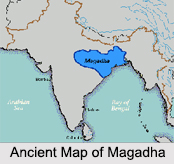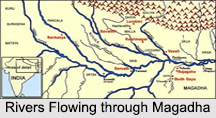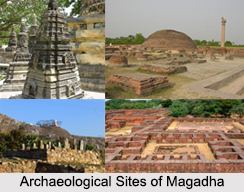 Magadha is a region in Bihar and formed one of the sixteen Mahajanapadas of ancient India. Magadha kingdom was the area of Bihar south of the Ganga River; its first capital was Rajagriha which is known as modern day Rajgir, then Pataliputra, modern Patna. Rajagriha was initially known as ‘Girivrijja’ and later came to be known as so during the reign of Ajatashatru. Magadha played an important role in the development of Jainism and Buddhism, and two of India’s greatest empires, the Maurya Empire and Gupta Empire, originated in Magadha. Magadha is a region in Bihar and formed one of the sixteen Mahajanapadas of ancient India. Magadha kingdom was the area of Bihar south of the Ganga River; its first capital was Rajagriha which is known as modern day Rajgir, then Pataliputra, modern Patna. Rajagriha was initially known as ‘Girivrijja’ and later came to be known as so during the reign of Ajatashatru. Magadha played an important role in the development of Jainism and Buddhism, and two of India’s greatest empires, the Maurya Empire and Gupta Empire, originated in Magadha.
Location of Magadha Magadha was situated in the eastern division of the 9 portions into which the sub-continent of India was divided. Magadha was bounded by the Ganga River on the north, by the district of Varanasi on the west, by Hiranyaparvata or Monghyr on the east, and by Kirana Supavana or Singhbhum on the south.  History of Magadha History of Magadha
Puranas, Buddhist canons and Jains Agamas noted the history of Magadha with the rule of different kingdoms. Magadha and its ancient capital Rajagriha were intimately associated with Lord Gautama Buddha and Buddhism. Mahabharata also noted the existence of Magadha. King Bimbisara of the Haryanka dynasty conquered some parts of Anga, which is known as the parts of West Bengal and Odisha. The capital of the Gupta Empire remained Pataliputra in Magadha. Dynastical Rule in Magadha Magadha was an important city of India because it was the centre of cultural change. The kings who ruled Magadha in the 7th century BC were enterprising. It was the seat of the Brihadratha dynasty, Pradyota dynasty, Shishunaga dynasty, Nanda Dynasty, Maurya Empire, Shunga Dynasty, Kanva Dynasty and the Gupta Empire. Culture of Magadha Indo Aryan culture was dominated in the ancient cultural history of Magadha. Buddhism, Jainism and Hinduism were the popular religion there. Buddhism and Jainism were promoted by the early Magadhan kings such as Srenika, Bimbisara and Ajatashatru, while Nanda Dynasty followed the Jainism.  People of Magadha People of Magadha
People of Magadha were also known as bards and traders in the Manava Dharmasashtra. It has been recorded that the people of Magadha were engaged in trade and commerce. The later texts recognise the Magadhans as a special caste, inventing their origin from inter-marriage among the old established castes. In the Apastamba Srauta Sutra, the Magadhans are mentioned along with other tribal people both of north and west India, viz. the Kalingas, the Gandharas, the Paraskaras and the Sauviras. Economy of Magadha Magadha was famous for conch shells. White elephants were used by the royal family. The agriculturewas prosperous, and that some Brahmins used to cultivate land themselves in Magadha. Magadha was also well divided for the purpose of cultivation, because of the existence of the snow fed rivers and the doab regions. Archaeological Sites in Magadha Archaeological sites in Magadha are the popular tourism destinations. Rajagriha, Son Bhandar Caves, Buddhist stupas, Ajatsatru Stupa, Bimbisara’s Palace, Archaeological sites in Nalanda and the caves of Buddha Era are the sites in Magadha. |
| |||
Magadha - Ancient City
| Magadha was an ancient East Indian city and the seat of administration of many eminent Indian rulers. Jainism and Buddhism are the two popular religions that originated in this region. |
| ||||||||||||||||||||||||||||













